
 vi and baking in par tic u lar, so when I was told that I could no longer eat wheat in any form, I was taken aback. And the diet sheet I was given seemed calculated to bring on severe depression. Torn between outrage and laughter, I decided that if life had handed me a lemon, I was going to fight back. Id cook it. As anyone who is new to cooking without wheat or gluten soon discovers, it was a bit like exploring a foreign cuisine and using unfamiliar ingredients. However, being a food writer, Im used to developing recipes, so I did have an advantage right out of the starting gate.
vi and baking in par tic u lar, so when I was told that I could no longer eat wheat in any form, I was taken aback. And the diet sheet I was given seemed calculated to bring on severe depression. Torn between outrage and laughter, I decided that if life had handed me a lemon, I was going to fight back. Id cook it. As anyone who is new to cooking without wheat or gluten soon discovers, it was a bit like exploring a foreign cuisine and using unfamiliar ingredients. However, being a food writer, Im used to developing recipes, so I did have an advantage right out of the starting gate.
Flours made from brown rice, quinoa, teff, chestnuts, almonds, and flax began to fill my freezer. Cakes, cookies, and tarts were no problem at all, and in fact often surpassed the originals made with wheat flour. Gratifyingly, foodie friends and associatesknowledgeable cooks with critical palatesall chorused the same refrain: Jackie, this is better than the wheat version. And lighter. Can I have the recipe? Bread was another matter, at least in the early days. Gluten- free flours lack structure: they dont interact with leavening to create a light, airy loaf.
The gluten- free bread one could buy was appalling, so I kept trying and finally hit upon the idea of returning to the small, round hearth breads of old. They have a crisp crust that contrasts with the soft interior, and being made with whole grains in true artisan style, theyre healthful as well as delicious. They are also very quick to stir together. Day- to- day cooking doesnt need all that much tweaking to make it gluten-free. After all, its just as easy to thicken a comforting stew with rice flour or cornstarch as it is with all- purpose flour, and sauted chicken breast tastes much better when coated with a mixture of ground hazelnuts and Parmesan than it ever did covered in stale boxed bread crumbs. Ive included a cross- section of recipes for everyday cooking and weekend entertaining that everyone at the table can relish, whether theyre gluten- sensitive or not.
Cooking necessarily involves buying ingredients, and gluten- sensitive shoppers do have to become hawk- eyed label checkers. Wheat can turn up in the most unex-pected places, like soy sauce, so youll find a buyers guide on page 4. Be aware that wheat free doesnt necessarily mean gluten-free. Happily, new labeling laws now coming into effect are making gluten- free shopping easier every day, and some chains, like Whole Foods and Trader Joes, offer pamphlets listing literally hundreds of gluten- free groceries, from corn spaghetti to Japa nese tamari sauce. There is a world beyond wheat, and a very rewarding one at that. I have thor-oughly enjoyed creating these recipes, and I hope that youand your family and friendswill enjoy them too.
A wheat allergy and celiac disease are not the same thing. When a person has a wheat allergy, his or her immune system has an abnormal reaction to the proteins in wheat. Other major food allergens include eggs, corn, fish and shellfish, milk, peanuts, soy, and tree nuts. When someone with celiac disease eats food containing gluten, part of the protein found in wheat, barley, and rye, it triggers an immune- system attack on the lining of the small intestine. The resultant damage, which prevents the body from absorbing nutrients properly, can lead to diarrhea, fatigue, nausea and weight loss, and of course, malnutrition. Many health professionals believe that untreated celiac diseasewhich often has no symptomscan lead to osteoporosis, anemia, infertility, and cancer.
A related condition, dermatitis herpetiformis, causes a distinctive weepy, itchy rash that frequently appears on the hands, behind the knees, and inside the elbows. Unfortunately, a dermatologist will rarely suggest that it might be caused by something you ate. Up until quite recently, it took an average of eleven years to get a correct diagnosis for celiac disease, partly because symptoms vary so much among individuals, and because it was thought to be a childhood ailment rarely seen in America. That point of view is changing. It is now estimated that celiac disease affects 0.5 percent to 1 percent of the U.S. (In Finland, its 2 percent of the population; in Italy, 1.2 percent and in northern Ireland, .09 percent.) Diagnosis is often difficult, as the symptoms can mimic other conditions such as Crohns disease, or be ascribed to irritable bowel syndrome. (In Finland, its 2 percent of the population; in Italy, 1.2 percent and in northern Ireland, .09 percent.) Diagnosis is often difficult, as the symptoms can mimic other conditions such as Crohns disease, or be ascribed to irritable bowel syndrome.
Blood tests can reveal celiac- related antibodies, but an intestinal bi-opsy is usually needed. Celiac disease is hereditary, though not all children of a parent with the disease will test positive. As with a food allergy, there is no cure other than avoiding the offending substance, at least so far. Still, this beats taking drugs with unknown long- term side effects. Although those of us with a wheat allergy or celiac disease must be vigilant about what we buy and eat, we dont have to forgo favorites like pasta, bread, and cake. We can still eat well and entertain family and friends at the table, perhaps even better and more healthfully than ever before.
Dining out also requires caution. Generous friends and relations who want to cook for you but are uncertain about the, um, gustatory limitations are no problemjust give them a copy of this book! Fast- food chains are generally off-limits, as the majority of their offerings involve wheat in one form or another. In any case, the food tends to arrive in those kitchens prepacked, and the staff has no idea whats actually in it. But here too, government regulations that demand full disclosure are starting to come into effect. All those people diagnosed with celiac disease, plus millions of others with various food allergies, do have a certain amount of clout. As celiac disease becomes better known among the general public, even chains are starting to offer gluten- free specials.
Youll find that the waiters in established restaurants are generally most helpful if you ask their advice about the menu, ex-plaining with regret that you cant eat anything containing wheat flour in the sauce (or dusted on before browning), bread crumbs, croutons, or pasta. Chefs are nurturing people by nature, and will usually make a big effort to take care of youand gain a happy repeat customer. theres a whole cornucopia of gluten- free grains, seeds, and nuts out there that have been cultivated since the dawn of civilization. Rice sustains more than half of the worlds population, and along with corn is the most obvious and useful alternative to wheat. In addition, theres South American amaranth and quinoa, East African teff, Asian millet (revered by the ancient Chinese as one of their Five Sacred Grains and the most widely used grain in India today), and northern Eu ro pe an buckwheat, which isnt wheat at all but botani-cally related to rhubarb. Nuts such as walnuts, almonds, pecans, and chestnuts make wonderful flour, as do dried beans.
Even cocoa can be utilized as a form of flour. I cant claim that this is a comprehensive list, but it does include those ingredients most readily available in the United States. Some grains are best when used whole in pilafs, others shine when ground into flour and used for baking, and most are good both ways. Nearly all of them are utilized as whole-grain flours, with all their nutrients intact, and provide healthful complex carbohydrates and fiber as well as good flavors. As a general rule, its best to buy nuts and gluten- free flours in small quantities and store them in the freezer or refrigerator. Being completely natural, they contain no preservatives or other dubious additions.
Next page



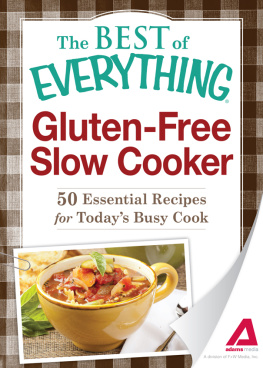
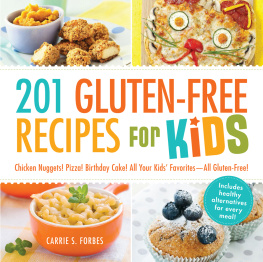

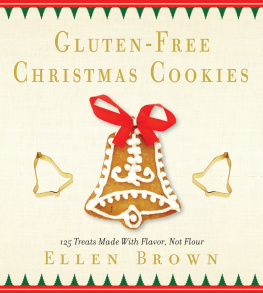
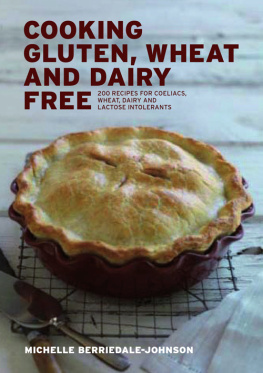
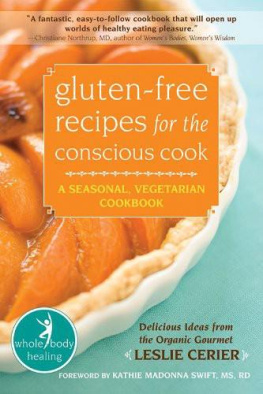

 vi and baking in par tic u lar, so when I was told that I could no longer eat wheat in any form, I was taken aback. And the diet sheet I was given seemed calculated to bring on severe depression. Torn between outrage and laughter, I decided that if life had handed me a lemon, I was going to fight back. Id cook it. As anyone who is new to cooking without wheat or gluten soon discovers, it was a bit like exploring a foreign cuisine and using unfamiliar ingredients. However, being a food writer, Im used to developing recipes, so I did have an advantage right out of the starting gate.
vi and baking in par tic u lar, so when I was told that I could no longer eat wheat in any form, I was taken aback. And the diet sheet I was given seemed calculated to bring on severe depression. Torn between outrage and laughter, I decided that if life had handed me a lemon, I was going to fight back. Id cook it. As anyone who is new to cooking without wheat or gluten soon discovers, it was a bit like exploring a foreign cuisine and using unfamiliar ingredients. However, being a food writer, Im used to developing recipes, so I did have an advantage right out of the starting gate.